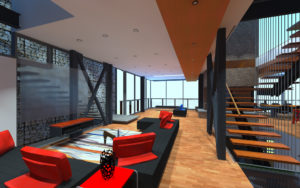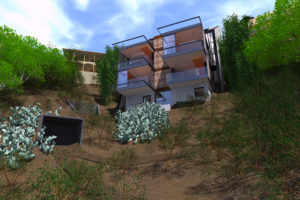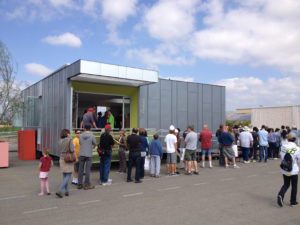I’m sorry to say, but 85% of so-called ‘green’ firms make some of the ugliest buildings that were ever made. So for God’s sake, I don’t want to be categorized with them.
~ Steven Holl
DTS Project House SUSTAINABILITY NARRATIVE
The moral imperative for sustainability is to improve and sustain the quality of life for human beings of current and future generations. The purpose of building sustainablly is to sustain the earth’s health soley to the extent that the earth’s health improves human beings use of the earth. There is no moral imperative to improve the earth’s health outside of making the earth more usable for human purposes. Although it is human nature to promote the expedient, sustainability is to rebel against human nature and promote what provides long term health and happiness. Sustainabilty and architecture are the tangible promotion of the long term physical, psychological, intellectual, and spiritual health of individuals and societies. Sustainability and architecture have the opportunity to promote these all important purposes of human existence in a myriad of ways.
Today, almost every aspect of life has been reduced to what is measurable, especialy sustainability. In addition to the measurable, the DTS Project House considers the immeasurable aspects of sustainability to make its design sustainable and thus architecture. Wonder, delight, and inspiration and the aesthetic experience are treated as more than equal to numeric driven technics prescribed by certification checklists in making a sustainable building. The DTS Project House recognizes that design that is about sustainability will never be sufficiently cherished to be truly sustainable.
The DTS Project House is intended as a defense of civilizing values that make the sustained city possible and simultaneously a conceptually and physically organic, performing, and flexible structure that adjusts to its environment and inhabitant’s changing requirements. Meaningful sustainable architecture envisions how to turn known quantifiable measurables into original unmeasurable aesthetic experiences. Like all significant architecture and enduring sustainability, the DTS Project House attempts to equally address the here and now and the visionary.
Institutions
Institutions sustain civilization and make an enduring city possible by socializing individuals. Thousands of years of history, most especially during its periods of breakdown, confirm the family is the most important institution for sustaining civilization because the family best mediates between the individual and the community – the two poles of human exsitence. Sustainable architecture must address these two poles by defending the importance of institutions, such as the family, and expressing the importance and necessity for institutions. Contrary to much current thought regarding the single family house, the public realm, and notions of sustainability, the decision to lavish effort on the single family residence is an act contributing immensely to the sustainability of the public realm. The DTS Project House’s first and maybe most significant contribution to sustainability and the public realm is to concretely declare the significance and importance of the family institution by undertaking the immense effort to construct the DTS Project House.
Among its design elements, the DTS Project House expressees the function and importance of the family institution in its expressed structure and use of rock filled gabions. Like institutional structures, the DTS Project House structure provides a visual, conceptual and physical stability that makes responsible individual freedom possible. The exposed structure reinforces the prime importance of structures that simultaneously provide stability and freedom ad the fact that neither can productively exist without the other. The DTS Project House’s physical structure makes the apparent defying of gravity possible. A firm organization allows a structure to responsibly have fewer boundaries. Liberation is both measured and made possible by structure.
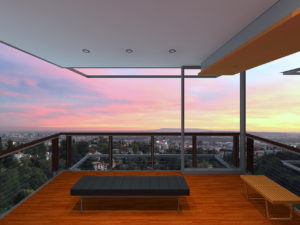
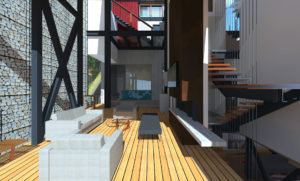
Like the family, the rock filled gabions, literally provide a filter between the individual and the community. The gabions act as a physical and metaphorical filter mediating between the DTS Project House inhabitants and its larger community. The physical filtering of privacy, light, and the environment are an expression of the institutional function of the family. The DTS Project House attempts to be sustainable by promoting one of the most important institutions promoting sustainability. The rock filled gabion walls also act as orientation devices and establish physical edges providing a clearly expressed boundary between group protection and personal liberation. The crossing of this boundary is an important spatial experience of the DTS Project House.
Institutions, especially the family, help orient the individual and make it possible for individuals to find their position in the larger communnity. The central stair helps inhabitants find their position within the DTS Project House and helps orient the DTS Project House within the City. The central stair serves as an orientation device helping locate yourself in plan and elevation and determine where you are in relation to other parts of the DTS Project House. Your connection to the other parts of the house through the central stair also makes you feel part of the larger whole. The open top of the central stair provides a light feature orienting the DTS Project House within the larger city and a sky view connectinng the DTS Project House to the larger universe. Connectedness and a larger purpose are what sustain individuals and thus the city.
Integration
Similar to a sustainable life, a sustainble building is necessarily an integrated building. Integration is combining multiple disparate parts together to form a healthy whole. Integration is bringing individuals together into membership in a group. Individuals alone are not sustainable entities but groups composed of individuals with the necessaary values are sustainable. Every aspect of the DTS Project House from design disciplines to design elements to materials to all manner of details was evaluated for both the strength of its individual identity and if and how it would reinforce the whole ensemble.
The DTS Project House attempts to conceptually and visually integrate competing individual project aspects to achieve a sustainable whole. Parts and elements, such as the rock filled gabions and central stair, have an individual identity and simultaneously contribute to the whole in a way that hopefully makes it near impossible to imagine the ensemble without each part. There is an attempt to only include parts and elements in the DTS Project House that sufficiently contribute to the architectural agenda and ensemble that they cannot be removed without losing the intended power of the whole. In this way every individual part contributes to sustainability of the whole. Any part that cannot make such a contribution is not necessary and only detracts from the strength of the other parts.

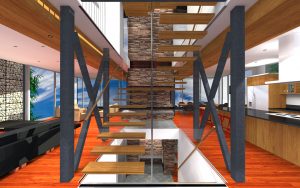
The parts of the DTS Project House often “complement” each other by making the attributes of other parts more visible and clearly expressed. The specific expressions of the compressive concrete and the tensile steel make tangible the uniqueness and individual attributes of the other. It is the juxtaposition and the contribution of each to creating the ensemble that ironically gives each its identity and makes it possible for each to best express itself. Sustainability necessarily has to integrate competing interests with the realization that if any interest is ignored the whole eventually becomes unsustainable.
Multiplicity
Elements contributing to a sustainable sustainability fulfill multiple roles and express more than a singular focus. Architecture that simultaneously addresses multiple concerns is sustainable and not just about sustainability. Like human beings, architecture and elements with a singular focus do not last or age well – they are not sustainable. Sustainability is about thriving with the the passage of time, not just lasting. The DTS Project House uses strategies and elements that simultaneously address multiple aspects of the architectural agenda which itself is much more than a singular focus.
The rock filled Gabion Walls are among the elements that simultaneously address multiple concerns: filtering natural and artificial light while mediating between the personal and the public; providing privacy and psychological protection while providing shade and environmental stability; connecting the structure to its Hollywoodland neighborhood and the hillside it rises from; recycling both the physical site and ancient ideas. The DTS Project House’s implementation of rock filled gabions gains its power and sustainability from its ability to fulfill multiple roles at once.
Past / Present / Future
Sustainable architecture equally considers and addresses the past, present, and future. Past, present, and future each exist in the short term and long term. Architecture must take a stance on what time frame, such as an individual’s lifetime, defines past, present, and future. Architecture, like anything sustainable, must connect to and conserve aspects of history, whether cultural, biological, or otherwise; must innovatively employ what currently exists from the physical to the intellectual to the political; and must contemplate what the future should look like but also prepare to adapt to an uncertain future.
The DTS Project House connects itself to the cultural history where it exists, employs strategies proven by time to provide for our well-being, and uses technologies and techniques tested by the passage of time. The DTS Project House employs current state of the art devices, contemplates how we should relate to the current state of nature and technology, and promotes today’s most important institution, the family. The DTS Project House is physically and conceptually sufficiently rigid to promote a stable future and physically and intellectually sufficiently flexible to adapt to unknown changing human and environmental factors. Sustainability looks to the past for what works, looks to the present for what is doable, and looks to the future for what ought to be.
Permanence / Flexibility
A sustainable design must be sufficiently stable to support the universal and sufficiently flexible to adapt to the particular. The architectural vision must express this tension by establishing a framework and standards that provide a criteria for making and evaluating individual actions, while simultaneously providing the flexibility for individuals to make choices. Architecture must provide both the physical and conceptual permanence and the physical and conceptual freedom necessary to address the needs of the communnity and the individual. Unless both needs are met, a building will not be sustainable. The expressed tension between group standards and individual freedom is among the design intentions to make the DTS Project House dynamic and thus sustainable.
The DTS Project House addresses the tension between permanence and freedom by establishing a stable conceptual and physical framework that allows for and promotes responsible individual choices. Physically and conceptually, the DTS Project House is permanently rooted to its hillside time and place through its structural design and through the use of the site’s physical geology installed in the gabions. The expressed structure provides an organization and visual framework that allows for a myriad of individual and temporary choices. The structure allows for individual lifestyle and aesthetic choices of furniture and artwork, configuration and reconfiguring of the space, annd use of spaces for varied functions without responsible choices degrading the structure and the architecture. In this way, the architecture is equally made for the specific family comissioning the DTS Project House and all families that may inhabit the house. The DTS Project House is made equally for the universal and the specific, for today and tomorrow, and is thus sustainable.
The expressed tension between standards and freedom extends to all aspects of the DTS Project House. The DTS Project House form and aesthetic is the direct result of resolving the expressed tensions between the concrete and steel structures, between the protective enclosure of the rock filled gabions and the gravity defying cantilevers, and between the anchored exposed steel structure and the floating freestanding furniture. In each case, the structure giving role of architecture is expressed and standards established, and in each case the standard is responsibly violated. Both the standard and the violation are made apparent and enhanced by the existence of the other – the exception proves the rule. The structure allows for and promotes individual choices and actions that make inhabiting the DTS Project House a dynamic experience.
The Home Automation system design serves as a case study for the effort expended in the DTS Project House design to establish stable structures that allow choice – the proper balance between open standards promoting choice versus stable closed systems. Typically, the major choice in home automation is limited to the choice of a propritary vendor, such as Savant and Control 4 among other manufactureres. Once this choice is made your home automation system is limited to this vendor’s products and which third party applications / devices the vendor allows you to integrate. The home automation system is forever reliant on the innovations of a single vendor and how open / closed the vendor decides to make their system.
The KNX protocal offers an alternative to a propritary vendor for home automation. KNX is not a vendor, but an open source protocol of standards that allows devices to communicate via a common language. KNX provides an open standard for any third party to design to so that its device can communicate with any other device designed to the KNX standard. Thus, the home automation system can benefit from the devices and inovations of an unlimited number of companies and there is no permission required to integrate with other devices designed to the KNX standard. Like many aspects of the DTS Project House, the home automation is a system of established known standards that instead of creating limits, promotes opportunities for a myriad of individual choices. In this way the home automation system is “future proofed” meaning it will remain useful and not become obsolete. Sustainability is “future proofing”.
Becoming
Life and buildings are sustainable as long as they remain in a state of becoming. Often buildings are at their most intresting while under construction, when they are still becoming. While still under construction our mind can imagine, shape, and impose our will on the building. Until its construction is complete, a building is still alive annd dynamic with potential. As soon as its construction is complete most buildings have a certainty that make them static and in a sense makes them dead. The challenge is to create an architecture that is sufficiently complete to provide stability and structure, but also exists in a state of constantly becoming. A sustainable building exists in both states simultaneously.
The DTS Project House’s architecture is intended to provide an aesthetic experience of constantly becoming. The DTS Project House is still in the process of searching for and reaching its full potential. The aesthetic of exposed concrete and structure highlighing the literal nuts and bolts of its construction is intended to make it ambiguous if the structure is finished or if the building is still under construction. The DTS Project House provides a framework upon which inhabitants can impose their changing and maturing vision of dwelling.
Various aspects of the DTS Project House, such as the exterior shades, central stair scrims, and freestanding furniture, are intended to provide a dynamic variability for a building in a constant search for the best version of its self. Along with the reconfigurable freestanding furniture, the exterior shades and central stair scrims have an almost infinite number of spatial combinations making the next experience of the building unknown. The best and most mature version of the DTS Project House is still in the future. A sustainable building is constantly becoming making its future as relevant as its past and present.
Waste
All buildings use resources, from monetary capital to human capital to natural materials. Sustainable buildings also use all of these resources, but more importantly do not waste these resources. All resources will eventually be used, so the important judgement is not always how many resources were used to make and operate a building, but does the building achieved put the resources used to their best use. Could the resources have been used elsewhere or differently to achieve more significance? A building that uses very few natural resources can still be a waste of those resources. A sustainable building does not waste human effort nor resources.
Every building will impact its environment and no building will not have negative impacts from some singular persepctive. The important question is what is achieved in exchage for any negative impacts. The fact that resources and time are limited is good and has the benefit of focusing and prioritizing our human efforts. The fact that what we build can negatively affect the world around us is a good thing because it means that what we build can also positively affect the world. The potential positive affects of what we build cannot exist without the existence of potential negative affects.
Most every building provides opportunities to achieve significance and a sustainable building does not waste these opportunities. The client, the site, the program, the historical moment, and many other project aspects all provide opportunities for a building to achieve significance. It is mills studio’s responsibility that the DTS Project House does not waste its opportunity to provide an architectural model of significant design, technology, and sustainability. Sustainable buildings reach their full potential and no matter its carbon footprint or utility bills, the DTS Project House is a wasted effort, and thus not truly sustainable, if it does not express in every aspect the full potential of its opportunities.
The initial resource the DTS Project House expends is the talent and time of its project consultants. The DTS Project House has a responsibility to use these resources to their fullest and achieve a finished building that neither wastes these individual efforts and creates a synergy that makes the DTS Project House greater than the sum of these individual efforts. The client’s charge and commitment of resources to create an architectural model of design, technology, and sustainability sets the minimum standard for evaluating if the DTS Project House has wasted its opportunity. Its hillside site and time of construction offers unique opportunities for the DTS Project House to only exist in its architectural form on this particular site at this particular time and making architecture particular, but not at the exclusion of the universal, is part of making architecture relevant and thus sustainable.
Design Process and Consultants
All project aspects from design to construction to landscape to engineering all have the opportunity and responsibility to contribute to the architectural agenda and make the building sustainable. mills studio’s initial Schematic Design identified elements of sustainability common to all of mills studio’s projects and proposed sustainable elements specific to the DTS Project House. The Schematic Design defined an attitude toward identifying and incorporating ancient and moderrn technologies that both align with mills studio’s architectural agenda and contribute to a sustainable building, such as the concrete thermal masses, solar chimney, and rock filled gabion walls.
Based upon the outlines of a Schematic Design, the DTS Project House’s design commenced in earnest with a design charette where mills studio and the Project Consultants defined and documented the project sustainability opportunities and goals and identified where these goals aligned with the architectural agenda. The Project Team identified the specific certification goal of LEED Platinum and articulated the strategies for project compliance to achieve this certification. The team recognized that some identified sustainabilty goals would not necessarily align with certification compliance. mills studio would have to make determinations whether sustainability or certification compliance were of the higher priority for certain design aspects. mills studio and consultants developed an outline program for data generation, data monitoring, and communication of data in order to determine how the building design might be affected by data.
Each aspect and discpline of the project was continually evaluated for how its implementation would contribute or detract from expressing the architectural agenda and contribute or detract to the project sustainability and certification goals. Project consultants, including Landscape Architect, Mechanical Engineer, Lighting Designer, and Green consultants are all LEED certified.
Research
Technologies directly and indirectly related to efforts to build and operate more sustainable architecture are in constant development. These technologies range from products using recycled content to manufacturing processes requiring less resources to devices and programs measuring and monitoring useful data to maintenance free products to product delivery and packaging producing less waste. As part of the DTS Project House’s research efforts, mills studio and the Owner’s have continually sought exposure to the most current developments in green technologies. These efforts include attending professional and consumer green trade shows, subscriptions to specific and general green trade journals, consultation with green and sustainability consultants and experts, attendance at green product launches, and visits to green buildings and exhibitions.
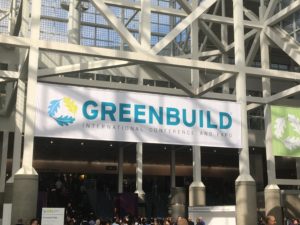

The amount of information associated with the number of green products and processes would quickly overwhelm without a clearly articulated evaluation criteria. Raw knowledge of products is of little consequence without an ability to accurately evaluate the claims of manufacturers and impartialy determine how products align with the DTS Project House’s architectural agenda and sustainability efforts. Going beyond virtue signalling requires a certain amount of scepticism about specific claims and if products and processes actually produce the stated sustainability results.
Thus, first, claims are confirmed to the extent possible. Rarely is the product under consideration the first a company has offered, so consideration of a company’s record of delivering promised results becomes relevant. Ignoring press release headlines and reviewing a manufacturer’s own published fine print data often tells a product’s actual story. And maybe most important is the wisdom of the crowd. It is extremely rare that a product has not been used, reviewed, and or evlauted by multiple experts and end users, so a thorough review of published product reviews, often in video format, provides valuable third party perspective.
And secondly, the evaluation criteria must confirm that the product or process will contribute, and best contribute, to the DTS Project House’s architectural agenda and sustainablity intentions. The established evaluation process avoids reducing the evaluation process to the soley expedient and often short-sighted meeting of compliance metrics and instead attempts a more innvolved evaluation that considers all of the competing interests relevant to long term sustainability. No product or device solely contributing to sustainability is acceptable in the DTS Project House. Products and devices must make contributions to multiple project aspects to be incorporated in the DTS Project House.
The research focus is not exclusively on current technological advancements, but also includes researching and evaluating much more ancient strategies, techniques, and materials, such as natural ventilation, the rock filled gabions, rammed earth, and solar chimney. As with the state of the art products and devices, the research of more venerable solutions includes establishing the efficacy of their conceptual basis and then how their practical application and implementation aligns with mills studio’s and the owner’s intentions for the DTS Project House.
LEED Certification
The Owners determined to seek LEED Certification as a recognizable expression of their commitment to sustainability. The DTS Project House is attempting to meet the design and construction requirements for LEED’s Platinum certification. An Industry Leader in green building and sustainability in general and in the US Green Building Council’s LEED program specifically, VCA Green was engaged as the Sustainability Consultant for the DTS Project House.
LEED certification is viewed as resulting from the design strategies, materials, and products that make up the DTS Project House. LEED certification is not intended to drive design decisions but to be the result of the design decisions. It is anticipated that few, if any, design decisions and choices should have to be altered for compliance with LEED certication. LEED certification should merely confirm that the design decisions we are already making for a myriad of reasons will contribute to making a sustainable building.
Technology
A significant aspect of sustainability is the technological response to scientific parameters that are both known and anticipated. The relevant scientific parameters for the DTS Project House are vast, including everything from earthquakes to fires to the enviroment to the availablity of resources to the human body. Technological responses work best when we realize that we are not eliminating but only manipulating these scientific parameters. No architecture can be built without impacting the larger world and no architecture can avoid being impacted by the larger world. Sustainability is not the elimination of our impact, but only a set of values defining how we mitigate and or channel our impact, and define how our building is impacted. Technology, from manufacturing processes to products and devices to software and programming, is one way the DTS Project House attempts to channel those impacts.
The DTS Project House’s technological responses reflect that some parameters, such as human nature, have not changed and will not change; other parameters are constantly changing, such as the environment; and still other paramters, such as earthquakes and climate, we are only able to guess at. Constant parameters such as the sun’s path are addressed with technologies, such as the rock filled gabion walls, that are physically, visually, and metaphorically stable, while changing parameters, such as the weather, are addressed with technologies that physically and visually adapt and learn from the inhabitants and buildings interactions.
The DTS Project House attempts to account not only for changing parameters impacting its ability to age and sustain, but also for technologies themselves that will change. Among the reasons photovoltaic panels were chosen over photovotaic roofing tiles was the ability to supplement and or change out the photovoltaic panels. The DTS Project House home automation system uses the KNX protocol instead of a propritary system for energy management in order to allow for the addition and replacement of devices and programming as companies continue to make more innovative products available.
The DTS Project House does not discriminate between ancient and modern technologies, such as rammed earth and photovoltaic panles, to make its architecture sustainable. The DTS Project House integrates passive technology, such as the solar chimney and rock filled gabion walls, with active technologies, such as the Daiken forced air system and exterior motorized shades. Much of the DTS Project House’s technology is employed to generate, monitor, and communicate the data necessary for the house to learn and operate sustainably.
Re-use and Recycling
The DTS Project House advocates for recycling in multiple project aspects. The DTS Project House recycles ideas that have proven their efficacy over time. Innovation in architecture is not best expressed in re-defining the purposes and goals of architecture, but instead is best expressed in how we use today’s resources and knowledge base to express those “recycled” purposes and goals of architecture, and also how we implement “recycled” strategies for expressing the purposes of architecture. Using rock filled gabions and rammed earth are not innovations, but how they specificaly integrate into the modern whole of the DTS Project House is the attempted innovation. Unfortunately, in the context of much of today’s building that eschews a venerable past, the intention to recycle ideas must be considered innovative.
The existing house was de-constructed so that finished products like cabinetry and doors were recycled and re-used in the Owner’s friend’s construction projects. Usable rough framing was provided to salvage companies for reuse. Products like glass and drywall that could not be salvaged intact were separated and delivered to the appropriate recycling companies.

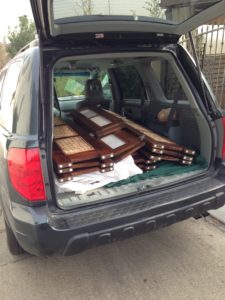
The DTS Project House uses materials and products that use recycled content and products and materials that can be recycled. The concrete uses 20-30% flyash (a byproduct from burning pulverized coal in electric power generating plants) depending on the concrete’s use as a wall, slab or foundation. The alumninum doors and windows are made from a sigificant per- centage of recycled content as well as the metal studs used for wall and soffit framing and all are 100% recycleable. The swimming pool is also made of 100% recycleable stainless steel the contains recycled content. Finish materials, like the extensive porcelain tile, also contain a significant amount of recycled material.
The DTS Project House recycles the site’s geology. The excavated rock and concrete is used to fill the gabion cages and dirt is used for rammed earth walls to conceptually and physically connect the house to its site, reduce efforts required to transport the excavated material off site and bring new materials on site, and intensifies the experience of the site’s natural resources. Rain water is recycled by storing in subterranean cisterns for use in irrigation.
The DTS Project House’s entire construction process pays attention to re-using and recycling. The concrete pours are sized and sequenced so that concrete wood formwork can be reused for multiple pours and then the forwork material is re-used for temporary controls like guardrails, stairs, and barriers. The waste material generated at the site is separated into recycleable categories and is either diposed of in the DWP recycling cans on site or is delivered to local Los Angeles County Community Recycling centers.
There is no ecological architecture, no intelligent architecture and no sustainable architecture – there is only good architecture.
~ Eduardo Souto de Moura
